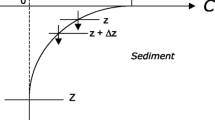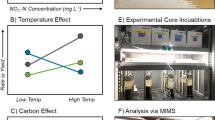Abstract
Denitrification rates and nitrous oxide (N2O) effluxes were measured at different temperatures and for different oxygen concentrations in the sediments of a eutrophied river entering the Bothnian Bay. The experiments were made in a laboratory microcosm with intact sediment samples. 15N-labelling was used to measure denitrification rates (Dw). The rates were measured at four temperatures (5, 10, 15 and 20°C) and with three oxygen inputs (<0.2, 5, and 10 mg O2 l−1). The temperature response was highly affected by oxygen concentration. At higher O2 concentrations (5 and 10 mg O2 l−1) a saturation over 10°C was observed, whereas the anoxic treatment (<0.2 mg O2 l−1) showed an exponential increase in the temperature interval with a Q 10 value of 3.1. The result is described with a combined statistical model. In contrast with overall denitrification, the N2O effluxes from sediments decreased with increasing temperature. The N2O effluxes had a lower response to oxygen than denitrification rates. The N2O/N2 ratio was always below 0.02. Increased temperatures in the future could enhance denitrification rates in boreal river sediments but would not increase the amount of N2O produced.



Similar content being viewed by others
References
Billen G (1978) A budget of nitrogen recycling in North Sea sediments of the Belgian coast. Estuar Coast Mar Sci 7:127–146
Blackmer AM, Bremmer JM (1976) Potential of soils as sink for nitrous oxide. Geophys Res Lett 3:739–742
Cavari BZ, Phelps G (1977) Denitrification in Lake Kinneret in the presence of oxygen. Freshw Biol 7:385–391
García-Ruiz R, Pattinson SN, Whitton BA (1998a) Denitrification in sediments of the fresh water tidal Yorkshire Ouse. Sci Total Environ 210/211:321–327
García-Ruiz R, Pattinson SN, Whitton BA (1998b) Nitrous oxide production in the river Swale-Ouse, North-East England. Water Res 33:1231–1237
García-Ruiz R, Pattinson SN, Whitton BA (1999) Kinetic parameters of denitrification in a river continuum. Appl Environ Microbiol 64:2533–2538
Hauck RD, Melsted SW, Yanlwitch PE (1958) Use of N-isotope distribution in nitrogen gas in the study of denitrification. Soil Sci 86:287–291
Helsinki Commission, Baltic Marine Environmental Protection Commission (HELCOM) (2003) The Baltic marine environment 1999–2002. Summary. Baltic Sea Environment Proceeding No. 87, pp 48
Holtan-Hartwig L, Dörsch P, Bakken LR (2002) Low temperature control of soil denitrifying communities: kinetics of N2O production and reduction. Soil Biol Biogeochem 34:1797–1806
Jensen K, Revsbech NP, Nielsen LP (1993) Microscale distribution of nitrification activity in sediment determined with a shielded microsensor for nitrate. Appl Environ Microbiol 59:3287–3296
Jørgensen KS (1989) Annual pattern of denitrification and nitrate ammonification in estuarine sediment. Appl Environ Microbiol 55:1841–1847
Kartal B, Kuypers MMM, Lavik K, Schalk J, den Camp HJMO, Jetten MSM, Strous M (2007) Anammox bacteria disguised as denitrifiers: nitrate reduction to dinitrogen gas via nitrite and ammonium. Environ Microbiol 9:635
Knowles R (1981) Denitrification, acetylene reduction, and methane metabolism in lake sediment exposed to acetylene. Appl Environ Microbiol 38:486–493
Knowles R (1982) Denitrification. Microbiol Rev 46:43–70
Kroeze C, Seitzinger SP (1998) Nitrogen inputs to rivers, estuaries and continental shelves and related nitrous oxide emissions in 1990 and 2050: a global model. Nutr Cycl Agroecosyst 52:195–212
Lepistö A, Granlund K, Kortelainen P, Räike A (2006) Nitrogen in river basins: sources, retention in the surface waters and peatlands, and fluxes to estuaries in Finland. Sci Total Environ 365:238–259
Letey J, Valoras N, Focht DD, Ryden JC (1981) Nitrous oxide production and reduction during denitrification as affected by redox potential. Soil Sci Soc Am J 45:727–730
Liikanen A, Flöjt L, Martikainen PJ (2002a) Gas dynamics in eutrophic lake sediments affected by oxygen nitrate and sulfate. J Environ Qual 31:338–349
Liikanen A, Tanskanen H, Murtoniemi T, Martikainen PJ (2002b) A laboratory microcosm for simultaneous gas and nutrient flux measurements in sediments. Boreal Environ Res 7:151–160
Maag M, Vinther FP (1996) Nitrous oxide emission by nitrification and denitrification in different soil types and at different soil moisture contents and temperatures. Appl Soil Ecol 4:5–14
McAuliffe C (1971) GC determination of solutes by multiple phase equilibration. Chemtechnology 1:46–51
Middelburg JJ, Klaver G, Nieuwenhuize J, Markusse RM, Vlug T, van der Nat FJWA (1995) Nitrous oxide emissions from estuarine intertidal sediments. Hydrobiologia 311:43–55
Nielsen K, Nielsen LP, Rasmussen P (1995) Estuarine nitrogen retention independently estimated by the denitrification rate and mass balance methods: a study of Norsminde Fjord, Denmark. Mar Ecol Prog Ser 119:275–283
Nowicki BL (1994) The effect of temperature, oxygen, salinity and nutrient enrichment on estuarine denitrification rates measured with modified nitrogen gas flux technique. Estuar Coast Shelf Sci 38:137–156
Nykänen H, Alm J, Lång K, Silvola J, Martikainen PJ (1995) Emissions of CH4, N2O and CO2 from a virgin fen and a fen drained for grassland in Finland. J Biogeogr 22:351–357
Ogilvie B, Nedwell DB, Harrison RM, Robinson A, Saqe A (1997) High nitrate, muddy estuaries as nitrogen sinks: the nitrogen budget of the River Colne estuary (United Kingdom). Mar Ecol Prog Ser 150:217–228
Öquist MG, Petrone K, Nilsson M, Klemedtsson L (2004) Nitrification controls N2O production rates in a frozen boreal forest soil. Soil Biol Biogeochem 39:1809–1811
Pattinson SN, García-Ruiz R, Whitton BA (1998) Spatial and seasonal variation in denitrification in the Swale-Ouse system, a river continuum. Sci Total Environ 210/211:289–305
Piña-Ochoa E, Álvares-Cobelas M (2006) Denitrification in aquatic environments: a cross-system analysis. Biogeochemistry 81:111–130
Rich PH (1975) Benthic metabolism of a soft-water lake. Verh Int Verein Limnol 19:1023–1028
Russow R, Stevens RJ, Laughlin RJ (1996) Accuracy and Precision for measurements of the mass ratio 30/28 in dinitrogen from air samples and its application to the investigation of N losses from soil by denitrification. Isot Environ Health Stud 32:289–297
Rysgaard S, Risgaard-Petersen S, Sloth NP, Jensen K, Nielsen SP (1994) Oxygen regulation of nitrification and denitrification in sediments. Limnol Oceanogr 39:1643–1652
Seitzinger SP (1998) Denitrification in freshwater and coastal marine ecosystems: ecological and geochemical significance. Limnol Oceanogr 33:702–724
Siegel RL, Hauck RD, Kurtz LT (1982) Determination of 30N2 and application to measurement of N2 evolution during denitrification. Soil Sci Soc 46:68–74
Silvennoinen H, Hietanen S, Liikanen A, Stange CF, Russow R, Kuparinen J, Martikainen PJ (2007) Denitrification in the river estuaries of the Northern Baltic Sea. Ambio 36:134–140
Stange CF (2007) A novel approach to combine response functions in ecological process modelling. Ecol Model 204:547–552
Stepanauskas R, Jørgensen NOG, Eigaard OR, Zvikas A, Tranvik LJ, Leonardson L (2002) Summer inputs of riverine nutrients to the Baltic Sea: bioavailability and eutrophication relevance. Ecol Monogr 72:579–597
Stockenberg A, Johnstone RW (1997) Benthic denitrification in the Gulf of Bothnia. Estuar Coastal Shelf Sci 45:835–843
Sørensen J, Jørgensen BB, Revsbech NP (1979) A comparison of oxygen nitrate and sulfate respiration in coastal marine sediment. Mar Ecol 5:105–115
Terry RE, Tate RL (1980) The effect of nitrate on nitrous oxide reduction in organic soils and sediments. Soil Sci Soc Am J 44:744–746
Vanderborght J, Wollast R, Billen G (1977) Kinetic models of diagenesis in disturbed sediments. Part 2. Diagenesis. Limnol Oceanogr 22:794–803
van Luijn F, Boers CM, Lijklema L (1996) Comparison of denitrification rates in lake sediments obtained by the N2 flux method, the 15N isotope pairing technique and the mass balance approach. Water Res 30:893–900
Acknowledgements
We thank Jaana Rintala (North Ostrobothnia Regional Environmental Centre) for the maps. Bernd Apelt is acknowledged for his assistance in the laboratory work, Antti Ollila for providing equipment for the sediment sampling, and anonymous referees for their valuable comments. This study was funded by the Academy of Finland (decision number 202429) and H.S. obtained funding from the foundation of Ella and Georg Ehrnrooth and from the Finnish Cultural Foundation.
Author information
Authors and Affiliations
Corresponding author
Rights and permissions
About this article
Cite this article
Silvennoinen, H., Liikanen, A., Torssonen, J. et al. Denitrification and N2O effluxes in the Bothnian Bay (northern Baltic Sea) river sediments as affected by temperature under different oxygen concentrations. Biogeochemistry 88, 63–72 (2008). https://doi.org/10.1007/s10533-008-9194-7
Received:
Accepted:
Published:
Issue Date:
DOI: https://doi.org/10.1007/s10533-008-9194-7




